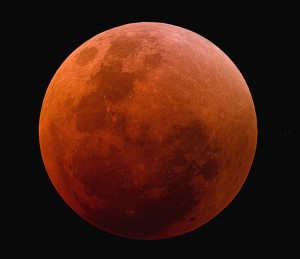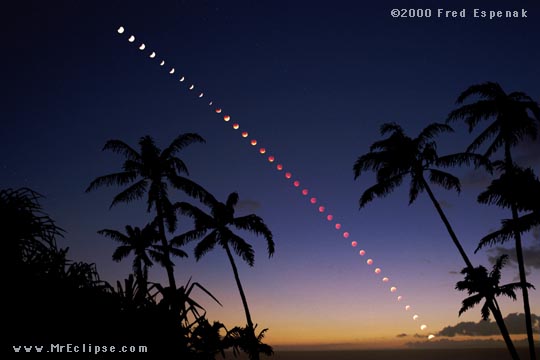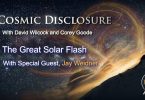Saleena Note: When I say it is a Blue Moon, that is from the perspective of more ancient times when the fourth Full Moon in a quarter, which is rare, was called a Blue Moon.
"There is a lunar eclipse on the night of December 20 or 21 – depending on your time zone. See below for the date in your location.
This December solstice eclipse is also the northernmost total lunar eclipse for several centuries.
There won’t be a total lunar eclipse this far north on the sky’s dome until December 21, 2485.
That’s because this eclipse is happening almost simultaneously with the December solstice – which in 2010 occurs on December 21 – when the sun will be southernmost for this year. Remember, a totally eclipsed full moon has to lie exactly opposite the sun. The winter sun rides low to the south now, as it crosses the sky each day. So this December full moon is far to the north on the sky’s dome. It rides high in the sky – much like the June solstice sun.
December 21 solstice marks day of southernmost sun
Remember, it’s the same eclipse –
happening in the same magical moments –
for all of us.
But our clocks will say different times.Places that see the lunar eclipse
during the night of December 20:
North and South America,
the islands of the Pacific,
Greenland,
Northwestern Europe
and
Northwestern Africa.For the islands of the Pacific,
Hawaii and Alaska,
the eclipse starts at early to mid-evening.On the U.S. West Coast,
the eclipse starts at late evening.As for the North American east coast
and the
South American west coast,
the eclipse happens in the predawn hours
on December 21.In Northwestern Europe,
Northwestern Africa
and the
South American East Coast,
the lunar eclipse is seen at or
close to dawn on December 21.
Places that see the lunar eclipse tomorrow –
on Tuesday evening, December 21.Northeast Asia,
the Philippines,
Eastern Indonesia,
Eastern Australia
and
New Zealand.The times for the eclipse – below – are listed in Universal Time (and U.S. time zones):
Times for the December 20/21 lunar eclipse.
Partial eclipse starts:
Dec 21 6:33 UT
Dec 21 1:33 a.m. Eastern Standard Time
Dec 21 12:33 a.m. Central Standard Time
Dec 20 11:33 p.m. Mountain Standard TimeDec 20 10:33 p.m. Pacific Standard Time
Total eclipse starts:
Dec 21 7:41 UT
Dec 21 2:41 a.m. Eastern Standard Time
Dec 21 1:41 a.m. Central Standard Time
Dec 21 12:41 a.m. Mountain Standard Time
Dec 20 11:41 p.m. Pacific Standard Time
Total eclipse ends:
Dec 21 8:53 UT
Dec 21 3:53 a.m. Eastern Standard Time
Dec 21 2:53 a.m. Central Standard Time
Dec 21 1:53 a.m. Mountain Standard Time
Dec 21 12:53 a.m. Pacific Standard Time
Partial eclipse ends:
Dec 21 10:01 UT
Dec 21 5:01 a.m. Eastern Standard Time
Dec 21 4:01 a.m. Central Standard Time
Dec 21 3:01 a.m. Mountain Standard Time
Dec 21 2:01 a.m. Pacific Standard Time
How do I translate Universal Time to my time?
A total lunar eclipse takes place whenever the moon passes right through the Earth’s dark umbral shadow. This can only happen at full moon, which is when the moon has swung directly opposite the sun in our sky, in its
monthly orbit of Earth. During tonight’s total lunar eclipse, the moon will be totally immersed in Earth’s shadow for 72 minutes. A partial eclipse lasting for nearly the same period of time will precede and follow the total eclipse. The entire eclipse from start to finish will last about 3.5 hours.
Cloudy where you are? Try NASA’s live webcam of the eclipse.
From EarthSky
From a Hawaiian Island Perspective
Here is something someone sent me for the perspective from the Hawaiian Islands:
If the weather cooperates, we’ll see a spectacular total lunar eclipse from the Hawaiian Islands on the evening on Monday, Dec 20.
About 9:45 p.m. to 10:50 p.m. on that evening, the moon should have a dark, eerie red color.
While we have lunar eclipses
of some sort every six months,
this is the
first total eclipse of the moon
in three years.
In a total lunar eclipse,
the entire moon goes into the
deep inner shadow of the earth.
The moon darkens dramatically,
and often turns deep red.
Before going any further, I need to discuss this really important issue of timing. This total lunar eclipse occurs on the evening of Monday, Dec. 20 in Hawaii, not Dec. 21.
This is a classic example of the problems we encounter in Hawaii with the times for celestial events. Such timings are generally given in Universal Time. Universal time means, roughly, “the time it is in Greenwich, England,” just outside of London.
Greenwich, like the rest of England, is 10 hours ahead of Hawaii (at least when England is not on Daylight Saving Time).
So when it’s 10 p.m. Dec. 20 in Hawaii
(the peak of the lunar eclipse),
it’s 8 a.m. Dec. 21 in Greenwich, England.
In Universal Time this is written as “0800 hours,” since Universal Time, like military time, doesn’t use ‘AM’ and ‘PM.’
So, you might see information about this upcoming lunar eclipse as occurring “Dec. 21”; but keep in mind that it occurs Dec. 21 in Universal Time.
This beautiful event will occur
Dec. 20 in Hawaii, and if you go out
and try to see the eclipse
on the evening of the Dec. 21,
you’ll be literally a day late.
Lunar eclipses occur when the earth comes in between the moon and sun. Lunar eclipses can only occur during full moons. Only then do we have a straight line between sun, earth and moon, with the earth in the middle. The earth blocks most of the sunlight and stops that light from hitting the moon.
If the earth had not atmosphere, the moon would turn black during a total lunar eclipse. However, we do have at atmosphere. As the sun’s light passes by earth on the way to the moon, earth itself blocks most of the light. In addition, the earth’s atmosphere blocks most of the sun’s light from passing through.
However, our atmosphere does allow the long wavelengths of red light to pass through the atmosphere and continue onwards to the moon. Thus, during lunar eclipses the moon does not turn black; it turns an eerie shade of dark red.
This deep-red effect is generally most noticeable during total lunar eclipses like the one Dec. 20. (During partial lunar eclipses, when only part of the moon is in the earth’s deep shadow, the reddish effect is not as striking.)
From the Hawaiian Islands, the lunar eclipse technically starts at 7:29 p.m. as the moon enters the faint outer shadow of the earth. However, you will not notice any darkening of the moon until at least 8:32 p.m. Hawaii Standard Time, when the moon begins to enter the deep inner shadow (umbra) of the earth. At that time, the moon will be about one-third of the way up in the eastern sky.
By 9:42 p.m., the moon will be entirely in the earth’s inner shadow, as the total phase of this lunar eclipse begins. At this time, the moon will be about halfway up in the eastern sky. By this time, the moon should be dramatically darker and redder and usual.
This total phase, with the moon completely within the earth’s umbra, will last till 10:52 p.m. By the time the total phase ends, the moon will be almost exactly overhead, in the very zenith of the sky.
As of 10:52 p.m. the moon will start to leave the umbra, and you will see the moon start to lighten. By midnight the moon will be entirely out of that dark inner shadow and will look like a regular full moon.
Technically this eclipse ends at 1:03 p.m. Dec. 21 as the moon leaves the penumbra completely.
While (some say) it is never safe to look at any phase of a solar eclipse (except for the few brief, rare moments of a total solar eclipse), lunar eclipses are completely safe for viewing. All you really need to view this event is clear skies.
As noted above, the moon will be halfway up in the eastern sky when the total phase starts at 9:42 p.m., so you should not have any interference from hills or buildings.
Another great thing about this eclipse is that the moon will very high overhead, especially here in Hawaii. As mentioned above, lunar eclipses only happen during full moons.
A full moon in December
follows the same path across
that the sun follows in June,
sweeping to the very top of the sky.
This Dec. 20 lunar eclipse occurs less than one day before the winter solstice. Within 24 hours we will see the full moon, in full eclipse, climb to the top of the sky Dec. 20; and then see the sun barely make it halfway up the southern sky at its highest point Dec. 21.
While solar eclipses are visible only over a small portion of the earth, half of the planet sees a lunar eclipse. This Dec. 20-21 eclipse will be visible throughout the Hawaiian Islands and throughout the eastern half of Polynesia (Tahiti, Easter Island, and Marquesas). This eclipse will also be total over nearly all of North America.
Read More
Happy New Moon & December Cosmic Events








